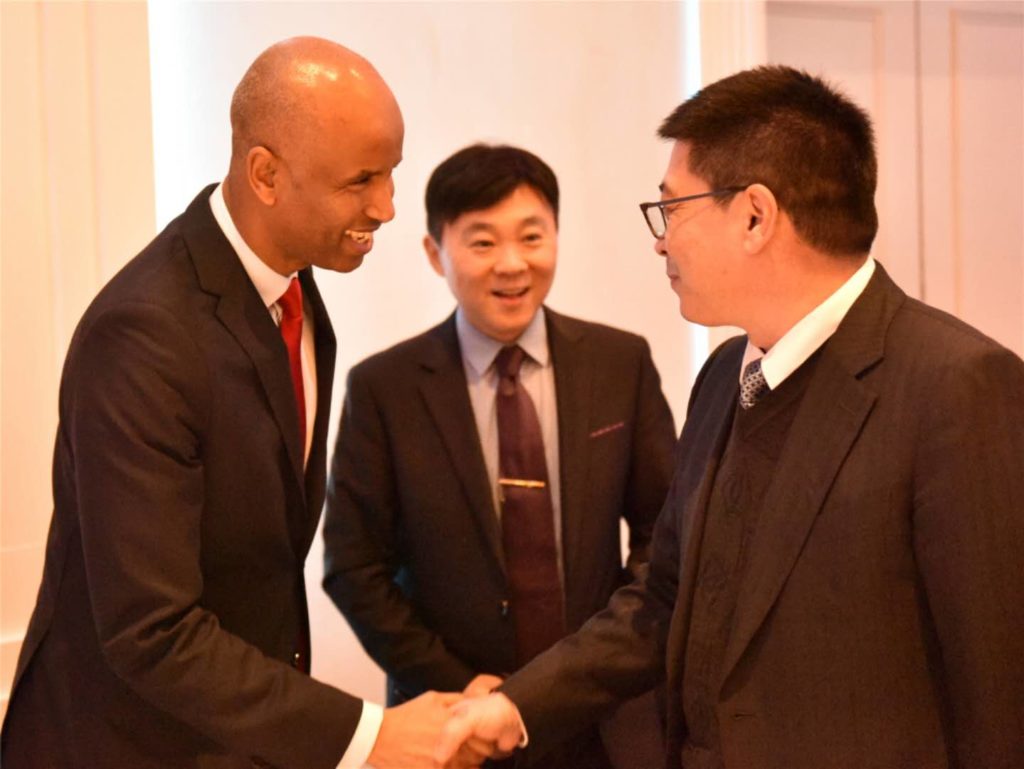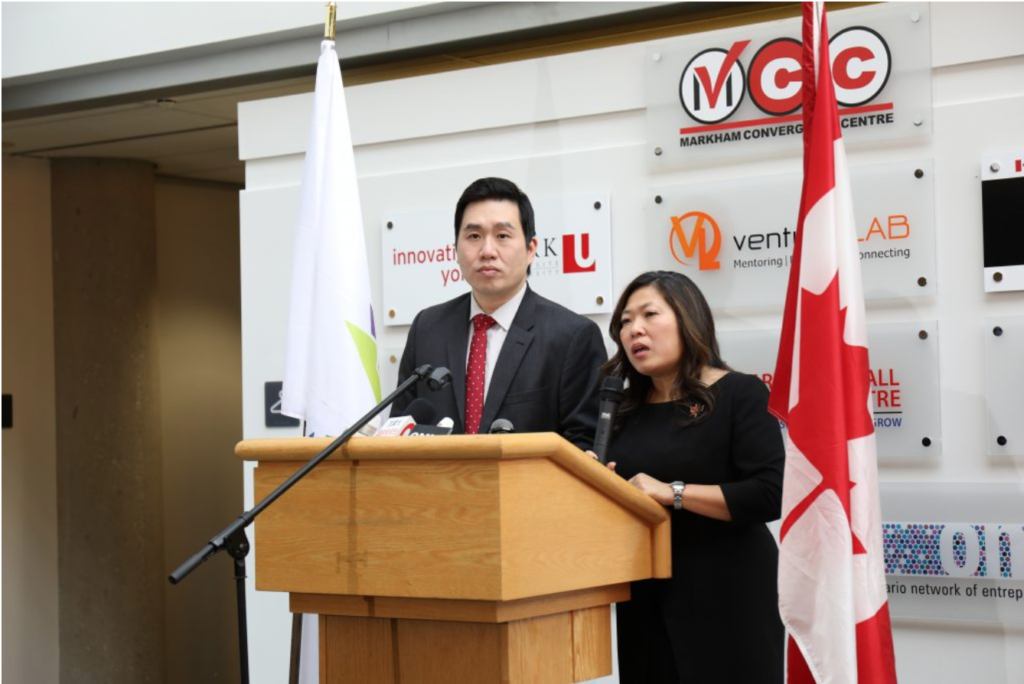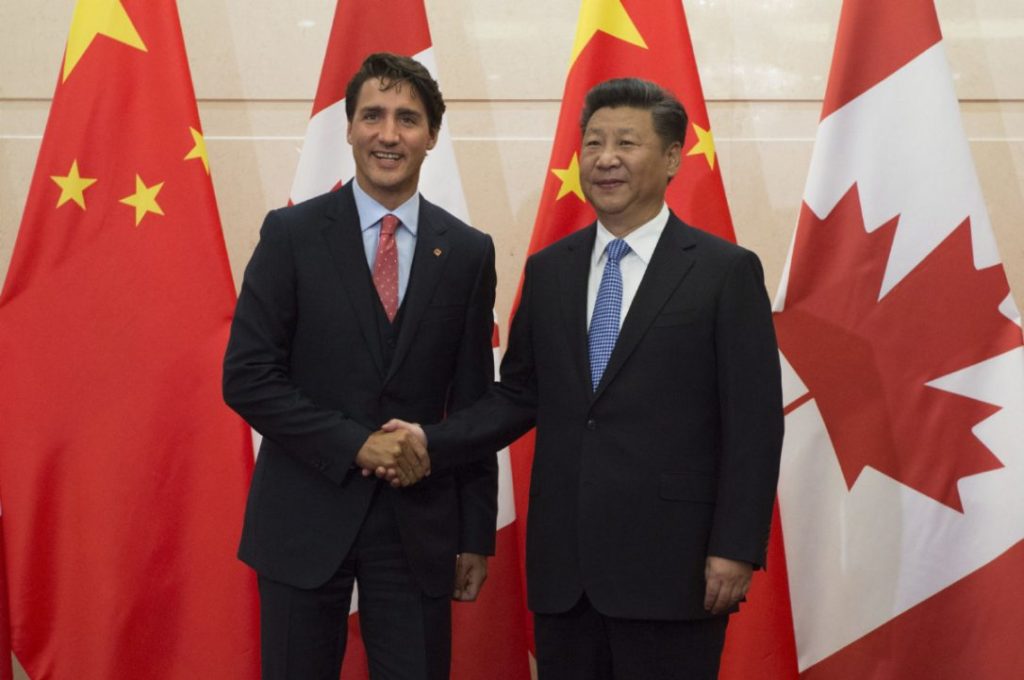Constitution of Canadian Association of Industry and Commerce
(Content was approved by the first general meeting of Canadian Association of Industry and Commerce on July 5, 2017)
Article 1: General Principles
- The abbreviation of “the Canadian Association of Industry and Commerce” is “CAAIC”.
- The Canadian Association of Industry and Commerce is a non-political, non-religious, non-profit federally registered organization. It is a national professional business association and mutual-aid group in industry and commerce, consisting of China-related entrepreneurs and businesses in Canada, together with Canada-related entrepreneurs and businesses in China.
- Canadian Association of Industry and Commerce seal and logo
- The seal of Canadian Association of Industry and Commerce consists of designed pattern and text (see Attachment).
- The address of Canadian Association of Industry and Commerce is Unit 912, 4789 Yonge Street, Toronto, Ontario, M2N 0G3.
- The Canadian Association of Industry and Commerce could establish its branches within Canada, with approval of its council.
Article 2: Objectives
2.1 The CAAIC, a non-profit organization, was founded and registered with federal government of Canada in 2017. Its mission is to provide services to following members, but not limited to, the fields such as industry, agriculture, service and commerce.
Our association is committed to work closely and effectively with China National Federation of Industry and Commerce, and its all sub-divisions at all provincial and municipal levels in cooperation and communication. We will strive to create and make best use of all potential business opportunities that should benefit both Canada and China.
We will dedicate to create more opportunities for entrepreneurs of both countries for meetings, forums, mutual studies and site visits in order to establish platforms for potential commercial exchange, trade and projects. Our goal is to establish a close tie and to promote mutual cooperation for the entrepreneurs of the two countries.
2.2 The purpose of this association is reflected in the following aspects:
2.2.1 giving full play to the Canadian Association of Industry and Commerce as Canada and China’s economic ties and role of the bridge; enhancing the image of Canadian Chinese businessmen; protecting their rights and interests; integrating resources from multi-level; seeking greater development
2.2.2 giving full play to the association’s advantage on familiarity of laws and business models from Canada and China; promoting the sharing of resources and experience; promoting mutual assistance and communication between members; safeguarding the legitimate rights and interests on behalf of its members
2.2.3 strengthening exchanges and cooperation with governments, business organizations, enterprises and other sectors; guiding and helping members in-depth understanding business environment and background of China and Canada; promoting faster and stronger business development
2.2.4 guiding the members to carry forward the traditional virtues of the Chinese nation, enthusiastic social welfare undertakings; actively participate in international charity activities; contribute back to the community during the course of enterprise development with honesty and law-abiding
2.2.5 providing advisory services in all aspects including business, taxation, finance, law and legislation; giving full play to internal dispute arbitration role among association members
Article 3: Organization
3.1 The Canadian Association of Industry and Commerce consists of the General Assembly, the CAAIC Council, and the Executive Council of the Executive Committee. The Canadian Association of Industry and Commerce has 12 industry committees.
3.2 The highest authority of the Canadian Association of Industry and Commerce is the General Assembly. The association initiators are established as members of the General Assembly. The responsibilities of the General Assembly members are the following:
3.2.1 formulating and amending the association constitution
3.2.2 electing and removing the councillors and directors
3.2.3 formulating and amending “the Administration Regulations of the Canadian Association of Industry and Commerce General Membership Fee ”
3.2.4 reviewing the financial report, the work report, and the budget for the following year of the association; determining the work policy and association policy for the next year
3.3 Members that registered with the Canadian Association of Industry and Commerce are required to appoint one delegate representing each corporation in writing to attend the General Assembly. Each delegate has the right to vote, and has a term of four years. The resolution of the General Assembly takes effect only if it is approved by more than half of the members that are required to be present at the General Assembly. The General Assembly resolution is considered invalid, if it is rejected by any vote from the members. The CAIA Council may decide to convene the General Assembly with consent in writing from at least 50% of the CAAIC Council members that have the voting rights.
3.4 Members of the CAAIC Council are, in principle, individuals and executives representing Canadian or Chinese enterprises that are legally registered in Canada and approved by the relevant government authorities. The initiators of the Canadian Association of Industry and Commerce automatically become members of the CAAIC Council.
3.5 The total number of members of the CAAIC Council must be odd. The CAAIC Council, as an executive body, must be accountable to the General Assembly; must coordinate and assist the General Assembly to handle the daily administration of the Canadian Association of Industry and Commerce.
3.6 The authorities and the responsibilities of the CAAIC Council are the following:
3.6.1 implementing the resolution of the General Assembly
3.6.2 electing and dismissing president, vice president, secretary general; voting on the nomination of the executive council
3.6.3 developing the objectives, principles and policies of the Canadian Association of Industry and Commerce
3.6.4 organizing and preparing the General Assembly; implementing annual work report, financial report to the General Assembly; developing work policy for the following year
3.6.5 discussing and deciding on issues or other matters submitted by the Executive Council of the Executive Committee
3.6.6 nominating new members of the CAAIC Council
3.6.7 proposing the CAAIC Council candidates for the next session
3.6.8 discussing and deciding on hiring consultants, lawyers and accountants for the Canadian Association of Industry and Commerce
3.7 The CAAIC Council meeting is held at least once every six months. The CAAIC Council may convene the council meeting with more than two-thirds of the council member being able to attend. The CAAIC Council meeting resolution must be passed by more than two-thirds of the council members.
3.8 The proposal of the CAAIC Council meeting to be convened may be raised by president or at least one third of the council members.
3.9 The new members of the CAAIC Council shall be endorsed by at least two of the current executive council members first; then shall be voted and approved by the meeting of the General Assembly.
3.10 If the member of the CAAIC Council himself or herself cannot attend the council meeting, he or she may appoint a representative in writing, and vote on his or her behalf.
3.11 The premises that the CAAIC Council members automatically lose the member qualification are the following:
3.11.1 The members of the CAAIC Council submit their resignations to the Canadian Association of Industry and Commerce in writing. Since the date of receipt of the resignation by the CAAIC, the qualification of the council membership has no longer been valid.
3.11.2 The members of the CAAIC Council are found guilty in judicial proceedings in any sovereign state. Since the date of the judgement, the qualification of the council membership has no longer been valid.
3.11.3 The members of the CAAIC Council are absent twice from the council meetings during one year with no proper reason. Since the date of the second absence from the Executive Council meeting, the qualification of the Executive Council membership has no longer been valid.
3.12 The members of the Executive Council shall be elected by the CAAIC Council.
3.13 As an executing body, the Executive Council must be responsible to the CAAIC Council; must coordinate and assist the council in handling the day-to-day administration of the Canadian Association of Industry and Commerce.
3.14 The authorities and responsibilities of the Executive Council are the following:
3.14.1 implementing the resolutions from the CAAIC Council
3.14.2 proposing candidates for the next Executive Council
3.14.3 proposing to the CAAIC Council to remove the president, vice president, the secretary general
3.14.4 developing the work program of the Canadian Association of Industry and Commerce; implementing the relevant work policies of the Canadian Association of Industry and Commerce
3.14.5 preparing for the CAAIC Council meetings; preparing CAAIC work report, financial report, and work policy for the following year
3.14.6 discussing and deciding on major matters and projects to be submitted to the CAAIC Council
3.14.7 nominating new members of the Executive Council
3.14.8 proposing and discussing on hiring consultants, lawyers, and accountants for the Canadian Association of Industry and Commerce
3.15 The Executive Council meeting is held at least once every six months. The Executive Council may convene the council meeting with more than two-thirds of the Executive Council member being able to attend. The Executive Council meeting resolution must be passed by more than two-thirds of the Executive Council members.
3.16 The proposal of the Executive Council meeting to be convened may be raised by president or at least one third of the Executive Council members.
3.17 The new members of the Executive Council shall be selected from the current general members of the CAAIC or the CAAIC Council and nominated to the CAAIC Council for resolution and approval by at least one of the current Executive Council members. The initiators of the CAAIC automatically become members of the Executive Council. The members of the Executive Council are appointed for a term of four years. If there is change to work, the members of the Executive Council may designate other member representatives to act as members of the Executive Council of the CAAIC, with approval from the Executive Council.
3.18 If the Executive Council member himself or herself cannot attend the meeting of the Executive Council, he or she may appoint a representative to participate and vote on his or her behalf. The designated representative must be a member of the Executive Council of CAAIC himself or herself.
3.19 The premises that the CAAIC Executive Council members automatically lose the member qualification are the following:
3.19.1 The members of the CAAIC Executive Council submit their resignations to the Canadian Association of Industry and Commerce in writing. Since the date of receipt of the resignation by the CAAIC, the qualification of the Executive Council membership has no longer been valid.
3.19.2 The members of the CAAIC Executive Council are found guilty in judicial proceedings in any sovereign state. Since the date of the judgement, the qualification of the Executive Council membership has no longer been valid.
3.19.3 The members of the CAAIC Executive Council are absent twice from the Executive Council meetings during one year with no proper reason. Since the date of the second absence from the Executive Council meeting, the qualification of the Executive Council membership has no longer been valid.
Article 4: President, Vice President, Secretary General, Treasury Secretary
4.1 One president and several vice presidents of the CAAIC shall be elected by the CAAIC Council, with term of four years. Both president and vice president positions may be re-elected.
4.2 The work of the CAAIC is conducted and distributed according the division of the Executive Council membership, and under the leadership of the president.
4.3 One Secretary General and several Deputy Secretaries General of the CAAIC shall be appointed by the Executive Council Executive Committee.
4.4 The Secretary General is responsible for the day-to-day administration of the CAAIC.
4.5 One Treasury Secretary of the CAAIC shall be appointed by the CAAIC Council, and is responsible for the CAAIC financial budgeting.
Article 5: Membership
5.1 Four categories of membership shall be set up in CAAIC:
5.1.1 initiating members, as sponsors, with voting rights
5.1.2 general members, as enterprise representatives and individuals, with voting rights
5.1.3 contact members with no voting rights
5.1.4 honorary members with no voting rights
5.2 Membership shall be extended to the individuals, enterprises, or other organizations with assessment and scrutiny; shall comply with the rules and regulations set by the CAAIC; shall pay full membership fees in a timely manner; shall perform the relevant duties according to the law and regulations.
5.3 The membership application shall be made by a formal written request to the CAAIC Council for approval, with a copy of official Canadian registration documentation.
5.4 Members’ Rights
5.4.1 Members of the CAAIC have the right to express opinions.
5.4.2 Members of the CAAIC have the right to participate in activities of the CAAIC with priority at membership price, or with free of charge.
5.4.3 Members of the CAAIC have the right to enjoy the priority in the services, advice, endorsements and opportunities provided in the CAAIC.
5.4.4 Members of the CAAIC have the right to enjoy other services and facilities provided by the CAAIC.
5.4.5 Members of the CAAIC have the right to vote and to be elected, with exception of the non-voting members.
5.4.6 Members of the CAAIC are entitled to understand the activities and financial situation of the CAAIC, and have the right to propose for improvement, with exception of the non-voting members.
5.5 Members’ Responsibilities
5.5.1 Members shall abide by the rules and regulations set by the CAAIC, and protect the image and reputation of the CAAIC.
5.5.2 Members shall carry out the decision of the CAAIC.
5.5.3 Members shall actively support and participate in the work and activities of the CAAIC.
5.5.4 Members shall actively advise and assist the CAAIC.
5.5.5 Members shall pay membership fees in full in a timely manner.
5.6 Contact Members
As conditional members, contact members shall comply with the relevant CAAIC Constitution, abide by the law, pay full membership fees in time, and perform the duties and obligations of the contact members. Any business or personal representatives of Canadian investment in China, business or personal representatives of Chinese investment in Canada, and interested businessmen or business representatives are available to the contact membership qualification of the CAAIC, with recommendation of the current members of CAAIC and approval from the CAAIC Council.
5.7 Contact member candidates shall submit a formal written application to the CAAIC Council for approval, along with a copy of the registration documentation of the business officially registered in Canada or China.
5.8 Honorary Members
As conditional members, honorary members shall abide by the rules and regulations of the CAAIC, perform the duties of the CAAIC. Honorary membership should be granted by the CAAIC, with recommendations from at least two of the current members, and the approval from the General Assembly. Honorary members are entitled to free membership, but have no rights to vote or be elected to be members of council. Other rights and obligations should be the same as affiliated members.
5.9 Termination of Membership
5.9.1 Members apply in writing to terminate their membership.
5.9.2 Members are deemed to have voluntarily waived their membership, when they are in arrears of membership fees for one year.
5.9.3 If the actions of the members have a negative impact on the image of the CAAIC or violate the relevant rules and regulations of the CAAIC, it may be brought to the CAAIC Council by at least two of the CAAIC members. The termination of their membership shall be approved by at least three quarters of the votes from the CAAIC Council.
Article 6: Financial and Asset Management
6.1 The CAAIC sources of funding consist of membership fees, sponsorship, service charges, physical income and other legal income.
6.2 The fiscal year of the CAAIC ends on December 31st of each year, unless otherwise amended by the CAAIC Council.
6.3 All the financial records and vouchers shall be kept by designated personnel, and be tabulated regularly. The financial statements shall be available to all members, within three months after the end of each fiscal year.
6.4 The standard of the membership fee shall be determined in accordance with the financial management system of the CAAIC, which is approved by the General Assembly. Membership fee is non refundable under all circumstances.
Article 7: Amendment
7.1 The amendments to the CAAIC Constitution shall be approved by the CAAIC Council, and approved by the General Assembly.
Article 8: Dissolution
8.1 The CAAIC Council may propose to terminate the Canadian Association of Industry and Commerce, in the case of merger, acquisition, or self-dissolution.
8.2 The motion of termination shall be subject to the approval of the General Assembly.
8.3 The Canadian Association of Industry and Commerce shall formally apply to the non profit organization registry for dissolution, and shall be terminated immediately upon approval.
8.4 After debts being paid off, any relevant surplus assets shall be used for the purpose of developing business related to the objectives of the CAAIC, or donated to charities.
Article 9: Appendix
9.1 The CAAIC Council reserves the right of the interpretation of the CAAIC Constitution.
9.2 The above content of the CAAIC Constitution was adopted at the first General Assembly meeting in July of 2017.
Organizational Structure
The Canadian Association of Industry and Commerce was established in July 2017. The highest authority of the CAAIC is the General Assembly. The CAAIC Council was also established as an executive body of the General Assembly. According to “the Canadian Association of Industry and Commerce”, the first CAAIC Council was elected by the first General Assembly, and consists of one President, five Vice Presidents, and one Secretary General. The Canadian Association of Industry and Commerce is located at Suite 916, 4789 Yonge Street, Toronto, Ontario, M2N 0G3, employing three office staffs. In order to implement the principle of democratic centralism, strengthen the collective leadership, and strive to promote the standardization of the operation of the Canadian Association of Industry and Commerce, a series of rules and regulations has been developed, including “the Canadian Association of Industry and Commerce Rules of Procedure”, “the Canadian Association of Industry and Commerce Organizational System”, “the Canadian Association of Industry and Commerce Office System”, “the Canadian Association of Industry and Commerce Financial Management System” and so on.






